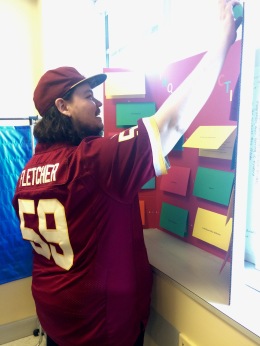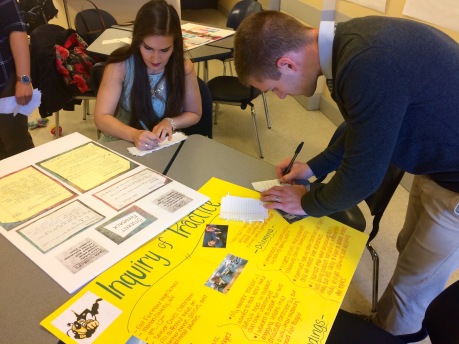This year, I’ve gotten away from a focus on online reading, writing, and grading, and returned to paper.
I’ve always kept certain things hard-copy–the writer’s notebook, one-pagers, and book talks–but when I started working with college students, Google Drive became my best friend. I used Slides to keep myself organized in class, Sheets to keep track of my grades, and Docs to collaborate with my students as we worked on their writing.
However, after a semester of forgotten deadlines, regrettably disconnected class sessions, and lackluster writing voices, I wanted to switch things up.
So, beginning in January, my students printed a one-pager about the week’s writing and brought it to class. When they gave presentations or shared their thinking, I asked them to bring a tangible artifact to represent their work. Any time we shared or offered up our thinking, we wrote notes to one another and signed them with our names.
These three practices, along with an emphasis on slowing down our thinking and being more deliberate in our work, language, reading, and interactions, made this semester one of my favorites in a ten-year career of teaching.
Sharing Hard-Copy Writing — I tried to build in class time weekly for us to pass one-pagers around and leave feedback. While this didn’t happen every week, it allowed for students to hear each other’s writing voices, discover new modes for representing their thinking, and come to a more dialogic understanding of the week’s readings rather than a “right or wrong” frame of mind. In her self-assessment for the course, Erin writes about the benefits of reading one another’s work:

Paper as an Artifact of Thinking — “I began writing this by going back and re- reading my writing from the beginning of this course. I still believe in some of the statements I made in my first one pager related to the beauty in the simplicity of a child’s world,”  Hanna began her self-assessment. Her ability to look back at her earliest writings as an artifact of who she was as a thinker 16 weeks ago allowed to her to launch into a detailed reflection on her growth over the course.
Hanna began her self-assessment. Her ability to look back at her earliest writings as an artifact of who she was as a thinker 16 weeks ago allowed to her to launch into a detailed reflection on her growth over the course.
In keeping with that theme, I asked my students to bring in an old-fashioned poster or trifold to share the thinking of their final projects. While they’d be turning in a more formal paper or Prezi during finals week, I wanted everyone to get to share their process tangibly. We engaged in a gallery walk during our last class period together, and the students enjoyed showing off their own thinking and comparing it to their fellow teachers’.
As they read, they jotted ideas in their own notebooks for how they might modify their own thinking before submitting it in final form. This type of physical engagement with one another’s work yielded far more interaction in terms of thinking and feedback than last semester’s format, in which I requested students send me three Google Slides about their work that we’d all share.

Keepsake Feedback — Keeping with the hard-copy theme, I devised a few new feedback protocols for students to give one another comments they could hang on to. While sharing the fruits of our semester-long inquiries, I asked students to engage in a “push and pull” with the writer. On one side of a piece of paper, they “pushed” the writer on some things they might take a little further or explain in more detail. On the other side, they told the writer what they had “pulled” from their work to enhance their own thinking.
In this way, students received feedback on these informal “drafts” of their thinking from their peers and from me, three weeks before they needed to finalize their assignment. When they turned in their notebooks at the end of the semester, I saw that many students had taped in their peers’ feedback to hang onto as both advice and encouragement.

By making our thinking visible this semester in the form of hard-copy papers that represent our thinking, posters or 3D representations of our ideas, and written feedback we can hang onto, I noticed a marked growth in my students’ progress. Their writing evolved throughout the semester to not only take on different forms, but also in its sophistication of content. My students all got to know one another well, even those in my class of 30. They learned about a diversity of perspectives and ideas beyond mine or their own that helped banish the idea of a “right or wrong” binary.
I really enjoyed my teaching, grading, and students this semester…and it was all thanks to paper.
How have you balanced integrating technology and keeping it old-school to help your students see one another’s thinking? Please share in the comments! I’d love some more ideas for next year.
Shana Karnes lives in West Virginia and teaches sophomore, junior, and senior preservice teachers at West Virginia University. She finds joy in all things learning, love, and literature as she teaches, mothers, and sings her way through life. Follow Shana on Twitter at @litreader.

[…] would prefer! When asked, many students echoed the belief I likely share with many of you: paper feedback is more authentic and creates connections). To date, my students have edited lab reports, history research, art analysis, even middle school […]
LikeLike
[…] feedback came next, with an inclusion of Shana’s “Push and Pull” feedback strategy. It was wonderful to see the details and voice emerge from their pieces. Celina had a line about […]
LikeLike
I am LOVING the ‘push and pull’ phenomenon. Thank you for this insightful thinking, S. And, of course, the use of ‘old school’…thanks for keeping it ‘real’. XOXOX E
LikeLiked by 1 person
Thanks, E! Miss you!!!!!! ❤
LikeLiked by 1 person
For a few years now I’ve done all my grading online. Students submit to me through google classroom, I attach a rubric, add comments, ect. Reading this post, I am struck by how hypocritical this is. I ONLY read physical copies of books (with a pen in hand no less); I use a handwritten planner opposed to my iPhone’s calendar app; I handwrite in a notebook and I love snail-mail. I began teaching just six years ago. At the time most teachers still required students to turn in hard copies of assignments. I felt hip and in-the-know for grading online. I felt current and up-to-date with educational practices. But just because something is traditional or old, doesn’t mean it’s wrong or bad. Boy…this post has got me thinking! With so much change in education, how do we know when the old is better than the new?
LikeLiked by 1 person
Colleen, what an insightful bit of reflection! I especially love that you recognize that something traditional isn’t necessarily “bad!” We are often too quick to vilify something because it’s been done before, but I think as long as we’re purposeful any practice can be beneficial for our students.
Hope to see you writing with us again soon…maybe your thinking about this idea can turn into another guest post! 🙂
LikeLike